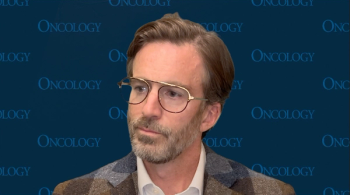
Fruquintinib Extends PFS in Pretreated Advanced NSCLC
The kinase inhibitor fruquintinib offered improved outcomes vs placebo as a third- and fourth-line treatment in advanced non–small-cell lung cancer.
The kinase inhibitor fruquintinib offered improved outcomes over placebo as a third- and fourth-line treatment in patients with advanced non–small-cell lung cancer (NSCLC), according to a new randomized study.
“There remains a major unmet need for effective and well-tolerated treatment options for patients with advanced NSCLC who have experienced treatment failure with chemotherapy and/or molecular targeted therapies,” wrote study authors led by Shun Lu, MD, of Shanghai Jiao Tong University in China. Fruquintinib is a highly selective inhibitor of vascular endothelial growth factor receptors 1, 2, and 3, with promising results in a phase I trial of several solid tumor types.
This phase II study randomized 91 patients from 12 hospitals in China to receive either fruquintinib (61 patients) or placebo (30 patients). All patients had experienced treatment failure with two standard chemotherapies, the first of which had to be a platinum-based doublet regimen. About half of the study population had EGFR mutations, and 70% of fruquintinib patients and 73% of placebo patients with those mutations had been previously treated with an EGFR tyrosine kinase inhibitor. The results of the study were
The median follow-up was 38.0 months in the fruquintinib group and 24.5 months in the placebo group. The median progression-free survival with the study drug was 3.8 months, compared with 1.1 months with placebo, for a hazard ratio (HR) of 0.34 (95% CI, 0.20–0.57; P < .001).
The median overall survival was 7.7 months with fruquintinib, and 9.7 months with placebo, for an HR of 0.70 (95% CI, 0.43–1.15; P = .152). The 3-month survival rate was higher with fruquintinib, at 90.2% compared with 73.3%; the same was true for 6-month survival, with rates of 67.2% and 58.8%, respectively.
The objective response rate was 13.1% with fruquintinib and 0% with placebo (P = .041). The disease control rate was also higher, at 60.7% compared with 13.3% (P < .001). Overall survival was numerically better with fruquintinib in patients with EGFR mutation–positive disease, at 8.4 months compared with 5.5 months with placebo, for an HR of 0.58 (95% CI, 0.30–1.141; P = .11). In contrast, wild-type EGFR patients had numerically longer overall survival with placebo than with the study drug.
All of the fruquintinib patients experienced at least one treatment-emergent adverse event (TEAE), compared with 90% of placebo patients. Most TEAEs were grade 1 or 2 in severity. Dose reductions were required in 21.3% of the fruquintinib patients and in 16.4% of placebo patients; 9.8% of fruquintinib patients had a TEAE that led to treatment discontinuation, compared with 3.3% in the placebo group. The most common TEAE in fruquintinib patients was hand-foot syndrome, reported in 49.2% of patients; other commonly reported TEAEs included proteinuria (32.8%), increased thyroid stimulating hormone level (27.9%), hoarseness (24.6%), and hypertension (23.0%).
“Fruquintinib seems to offer a treatment option for patients with advanced NSCLC who have experienced treatment failure with two lines of standard chemotherapy,” the authors concluded. They noted that further data on improved overall survival with the drug is expected from a randomized phase III trial (
Newsletter
Stay up to date on recent advances in the multidisciplinary approach to cancer.


















































































